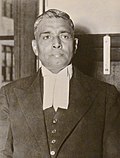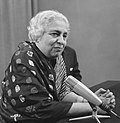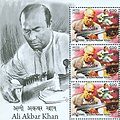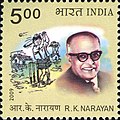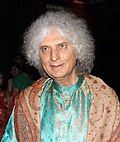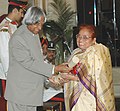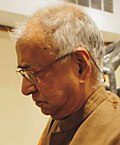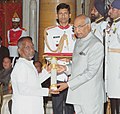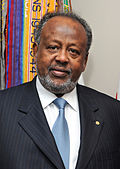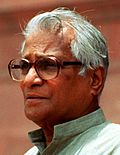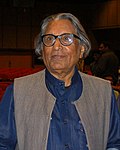Top Qs
Timeline
Chat
Perspective
List of Padma Vibhushan award recipients
From Wikipedia, the free encyclopedia
Remove ads
The Padma Vibhushan is the second highest civilian award of the Republic of India. Instituted on 2 January 1954,[1] the award is given for the "exceptional and distinguished service", without distinction of race, occupation, position, or sex. The Padma Vibhushan award recipients are announced every year on Republic Day and registered in The Gazette of India—a publication released weekly by the Department of Publication, Ministry of Urban Development used for official government notices.[2] The conferral of the award is not considered official without its publication in the Gazette. Recipients whose awards have been revoked or restored, both of which require the authority of the President, are also registered in the Gazette and are required to surrender their medals when their names are struck from the register.[3] As of 2020[update], none of the conferments of Padma Vibhushan have been revoked or restored. The recommendations are received from all the state and the union territory governments, the Ministries of the Government, the Bharat Ratna and previous Padma Vibhushan award recipients, the Institutes of Excellence, the Ministers, the Chief Ministers and the Governors of State, and the Members of Parliament including private individuals. The recommendations received during 1 May and 15 September of every year are submitted to the Padma Awards Committee, constituted by the Prime Minister. The committee recommendations are later submitted to the Prime Minister and the President for the further approval.[2]
When instituted in 1954, the Padma Vibhushan was classified as "Pahla Varg" (Class I) under the three-tier Padma Vibhushan awards; preceded by the Bharat Ratna, the highest civilian award,[4] and followed by "Dusra Varg" (Class II), and "Tisra Varg" (Class III).[1] On 15 January 1955, the Padma Vibhushan was reclassified into three different awards; the Padma Vibhushan, the highest of the three, followed by the Padma Bhushan and the Padma Shri. The criteria includes "exceptional and distinguished service in any field including service rendered by Government servants" but excluding those working with the Public sector undertakings with the exception of doctors and scientists. The 1954 statutes did not allow posthumous awards but this was subsequently modified in the January 1955 statute.[2][3] The award, along with other personal civil honours, was briefly suspended twice in its history;[5] for the first time in July 1977 when Morarji Desai was sworn in as the fourth Prime Minister.[6][7] The suspension was rescinded on 25 January 1980, after Indira Gandhi became the Prime Minister.[8] The civilian awards were suspended again in mid-1992, when two Public-Interest Litigations were filed in the High Courts questioning the civilian awards being "Titles" per an interpretation of Article 18 (1) of the Constitution.[5][a] The awards were reintroduced by the Supreme Court in December 1995, following the conclusion of the litigation.[10]
The recipients receive a Sanad (certificate) signed by the President and a medal with no monetary grant associated with the award.[2] The decoration is a circular-shaped toned bronze medallion 1+3⁄4 inches (44 mm) in diameter and 1⁄8 inch (3.2 mm) thick. The centrally placed pattern made of outer lines of a square of 1+3⁄16 inches (30 mm) side is embossed with a knob embossed within each of the outer angles of the pattern. A raised circular space of diameter 1+1⁄16 inches (27 mm) is placed at the centre of the decoration. A centrally located lotus flower is embossed on the obverse side of the medal and the text "Padma" written in Devanagari script is placed above and the text "Vibhushan" is placed below the lotus. The Emblem of India is placed in the centre of the reverse side with the national motto, "Satyameva Jayate" (Truth alone triumphs) in Devanagari Script, inscribed on the lower edge. The rim, the edges and all embossing on either side is of white gold with the text "Padma Vibhushan" of silver gilt. The medal is suspended by a pink riband 1+1⁄4 inches (32 mm) in width.[3] It is ranked fourth in the order of precedence of wearing of medals and decorations.[11]
The first recipients of the Padma Vibhushan were Satyendra Nath Bose, Nandalal Bose, Zakir Husain, Balasaheb Gangadhar Kher, V. K. Krishna Menon, and Jigme Dorji Wangchuck, who were honoured in 1954. As of 2025[update], the award has been bestowed on 343 individuals, including thirty-two posthumous and twenty-five non-citizen recipients.[12] Some of the recipients have refused or returned their awards; P. N. Haksar,[b] Vilayat Khan,[c] E. M. S. Namboodiripad,[d] Swami Ranganathananda,[e] and Manikonda Chalapathi Rau refused the award; the family members of Lakshmi Chand Jain (2011) and Sharad Anantrao Joshi (2016) declined their posthumous conferments,[f][g] and 1986 recipient Baba Amte and 2015 recipient Parkash Singh Badal returned theirs honour in 1991 and 2020 respectively.[21][h][23][i] The 2025 award was bestowed upon seven recipients – D. Nageshwara Reddy, Jagdish Singh Khehar, Kumudini Lakhia, L. Subramaniam, M. T. Vasudevan Nair (posthumous), Osamu Suzuki (posthumous) and Sharda Sinha (posthumous).[24]
Remove ads
Recipients
* Non-citizen recipient |
# Posthumous recipient |
Remove ads
Explanatory notes
- Per Article 18 (1) of the Constitution of India: Abolition of titles, "no title, not being a military or academic distinction, shall be conferred by the State".[7][9]
- P. N. Haksar was offered the award in 1973 for, among other services, his crucial diplomatic role in brokering the Indo-Soviet Treaty of Friendship and Cooperation and the Shimla Agreement, but declined as "Accepting an award for work done somehow causes an inexplicable discomfort to me."[13]
- Vilayat Khan refused Padma Shri (1964), Padma Bhushan (1968), and Padma Vibhushan (2000) and stated that "the selection committees were incompetent to judge [his] music".[14][15]
- E. M. S. Namboodiripad, the General Secretary of the Communist Party of India (of the Communist Party of India (Marxist) from 1964) and the first Chief Minister of Kerala (1957-59, 1967-69), declined the award in 1992, as it went against his nature to accept a state honour.[16]
- Swami Ranganathananda declined the award in 2000 as it was conferred to him as an individual and not to the Ramakrishna Mission.[15][17]
- Lakshmi Chand Jain died on 14 November 2010, at the age of 84.[18] His family refused to accept the posthumous honour as Jain was against accepting state honours.[19]
- Sharad Anantrao Joshi's family refused to accept the posthumous honour as Joshi's work for good of farmers is not reflected in the Government policies for them.[20]
- In 1991, Baba Amte returned the award, along with the Padma Shri conferred in 1971, to protest against the treatment given to the tribals during the construction of Sardar Sarovar Dam.[22]
- In 2020, Parkash Singh Badal returned the award in solidarity with the farmers protest.
- Posthumous recipients
- Suranjan Das died on 10 January 1970, at the age of 49.
- Ghulam Mohammed Sadiq died on 12 December 1971, at the age of 59.[25]
- Vikram Sarabhai died on 30 December 1971, at the age of 52.[26]
- Gurmukh Singh Musafir died on 18 January 1976, at the age of 77.
- Ali Yavar Jung died on 11 December 1976, at the age of 70.
- Arun Shridhar Vaidya was assassinated by Sikh extremists on 10 August 1986.[28]
- Mahadevi Varma died on 11 September 1987, at the age of 80.
- Ravi Narayana Reddy died on 9 September 1991, at the age of 83.
- V. Shantaram died on 30 October 1990, at the age of 88.
- Lallan Prasad Singh died on 9 November 1998, at the age of 86.[29]
- Jyotindra Nath Dixit died on 3 January 2005, at the age of 68.[30]
- Edmund Hillary died on 11 January 2008, at the age of 88.[32]
- Bhupen Hazarika died on 5 November 2011, at the age of 85.[33]
- Mario Miranda died on 11 December 2011, at the age of 85.[34]
- Dhirubhai Ambani died on 6 July 2002, at the age of 69.[35]
- Sunder Lal Patwa died on 28 December 2016, at the age of 92.[36]
- P. A. Sangma died on 4 March 2016, at the age of 68.[37]
- George Fernandes died on 29 January 2019, at the age of 88.[38]
- Arun Jaitley died on 24 August 2019, at the age of 66.[39]
- Sushma Swaraj died on 6 August 2019, at the age of 67.[40]
- Vishwesha Teertha died on 29 December 2019, at the age of 88.[41]
- S. P. Balasubrahmanyam died on 25 September 2020, at the age of 74.
- Narinder Singh Kapany died on 4 December 2020, at the age of 94.
- Radheshyam Khemka died on 4 April 2021, at the age of 86.[42]
- General Bipin Rawat died on 8 December 2021, at the age of 63.
- Kalyan Singh died on 21 August 2021, at the age of 89.[43]
- Balakrishna Doshi died on 24 January 2023, at the age of 95.[44]
- Dilip Mahalanabis died on 16 October 2022, at the age of 87.[45]
- Mulayam Singh Yadav died on 10 October 2022, at the age of 82.[46]
- Bindeshwar Pathak died on 15 August 2023, at the age of 80.
- M. T. Vasudevan Nair died on 25 December 2024, at the age of 91.[47]
- Osamu Suzuki died on 25 December 2024, at the age of 94.[48]
- Sharda Sinha died on 5 November 2024, at the age of 72.[49]
Remove ads
References
Bibliography
External links
Wikiwand - on
Seamless Wikipedia browsing. On steroids.
Remove ads

















